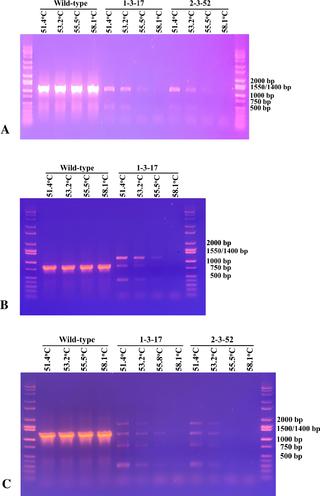PLOS ONE ( IF 2.9 ) Pub Date : 2020-03-27 , DOI: 10.1371/journal.pone.0230915 Jenq-Kuen Huang 1 , Kadidia Samassekou 1 , Hekmat B Alhmadi 1 , David R VanDerway 1 , Joshua D Diaz 1 , Jacob A Seiver 1 , Shawn W McClenahan 1 , Scott M Holt 2 , Lisa Wen 1

|
Nocardia cholesterolicum NRRL 5767 is well-known for its ability to convert oleic acid to 10-hydroxystearic acid (~88%, w/w) and 10-ketostearic acid (~11%, w/w). Conversion of oleic acid to 10-hydroxystearic acid and then to 10-ketostearic acid has been proposed to be catalyzed by oleate hydratase and secondary alcohol dehydrogenase, respectively. Hydroxy fatty acids are value-added with many industrial applications. The objective of this study was to improve the Nocardia cholesterolicum NRRL5767 strain by CRISPR/Cas9 genome editing technology to knockout the secondary alcohol dehydrogenase gene, thus blocking the conversion of 10-hydroxystearic acid to 10-ketostearic acid. The improved strain would produce 10-hydroxystearic acid solely from oleic acid. Such improvement would enhance the production of 10-hydroxystearic acid by eliminating downstream separation of 10-hydroxystearic acid from 10-ketostearic acid. Here, we report: (1) Molecular cloning and characterization of two functional recombinant oleate hydratase isozymes and a functional recombinant secondary alcohol dehydrogenase from Nocardia cholesterolicum NRRL5767. Existence of two oleate hydratase isozymes may explain the high conversion yield of 10-hydroxystearic acid from oleic acid. (2) Construction of a CRISPR/Cas9/sgRNA chimeric plasmid that specifically targeted the secondary alcohol dehydrogenase gene by Golden Gate Assembly. (3) Transformation of the chimeric plasmid into Nocardia cholesterolicum NRRL 5767 by electroporation and screening of secondary alcohol dehydrogenase knockout mutants. Two mutants were validated by their lack of secondary alcohol dehydrogenase activity at the protein level and mutation at the targeted 5’ coding region and the 5’ upstream at the DNA level. The knockout mutants offer improvements by converting added oleic acid to solely 10-hydroxystearic acid, thus eliminating downstream separation of 10-hydroxystearic acid from 10-ketostearic acid. To the best of our knowledge, we report the first successful knockout of a target gene in the Nocardia species using CRISPR/Cas9/sgRNA-mediated genome editing technology.
中文翻译:

利用CRISPR / Cas9基因组编辑技术敲除诺卡氏菌NRRL 5767中的仲醇脱氢酶。
诺卡氏菌NRRL 5767以其将油酸转化为10-羟基硬脂酸(〜88%,w / w)和10-酮硬脂酸(〜11%,w / w)的能力而闻名。已提出分别通过油酸酯水合酶和仲醇脱氢酶催化将油酸转化为10-羟基硬脂酸,然后转化为10-酮硬脂酸。羟基脂肪酸在许多工业应用中具有附加值。这项研究的目的是通过CRISPR / Cas9基因组编辑技术改善胆固醇诺卡氏菌NRRL5767菌株,以敲除仲醇脱氢酶基因,从而阻止了10-羟基硬脂酸向10-酮硬脂酸的转化。改进的菌株将仅由油酸产生10-羟基硬脂酸。通过消除从10-酮硬脂酸中下游分离10-羟基硬脂酸,这种改进将提高10-羟基硬脂酸的生产。在这里,我们报告:(1)从诺卡氏菌NRRL5767的两个功能重组油酸水合酶同工酶和功能重组仲醇脱氢酶的分子克隆和表征。两个油酸水合酶同工酶的存在可以解释10-羟基硬脂酸从油酸的高转化率。(2)特异性靶向仲醇脱氢酶的CRISPR / Cas9 / sgRNA嵌合质粒的构建金门大会的基因。(3)通过电穿孔将嵌合质粒转化为胆固醇诺卡氏菌NRRL 5767,并筛选仲醇脱氢酶敲除突变体。通过在蛋白质水平上缺乏仲醇脱氢酶活性以及在目标5'编码区和DNA水平上5'上游的突变来验证两个突变体的缺乏。敲除突变体通过将添加的油酸仅转化为10-羟基硬脂酸而提供了改进,从而消除了10-羟基硬脂酸与10-羟基硬脂酸的下游分离。据我们所知,我们报告了使用CRISPR / Cas9 / sgRNA介导的基因组编辑技术在诺卡氏菌物种中首次成功敲除靶基因。











































 京公网安备 11010802027423号
京公网安备 11010802027423号